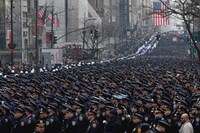The progressive City Council in Burlington, Vt., thought it was striking a blow for social justice when, in June 2020 — just after George Floyd’s murder — it cut the police force’s authorized strength from 104 officers to 74. Morale plunged, many cops quit and a downsizing intended to occur gradually through attrition happened precipitously.
Why more police might be the key to real criminal justice reform

Now, the city of 44,000 has 61 officers, 53 of whom are “actively deployed.” According to a recent New York Times report, organized bicycle theft and open-air drug sales have proliferated. Police in October said there had been four murders since July, as opposed to zero in the preceding two years.
Citizens have organized their own “bike recovery” group, which rides in search of thieves “like a posse from an old western,” according to the Times, though the group’s rules warn against vigilantism.
Burlington’s experience illustrates why mainstream Democrats were wise to distance themselves from proposals to “defund the police” — though the party still remains vulnerable politically on crime, even after a strong performance in the midterm elections.
Follow Charles Lane‘s opinions
FollowIt also provides some real-world context for an ideologically eclectic analysis of the relationship among crime, incarceration and social justice: “The Injustice of Under-Policing in America,” published earlier this year by Christopher Lewis of Harvard Law School and Adaner Usmani, of Harvard’s sociology department, argues that progress on all three fronts could require a substantial increase in police on America’s streets. The article, which appeared in a scholarly journal, merits amplification beyond the scattered mentions, mostly from academics, it has so far received online.
Criminal justice reformers often decry the much higher incarceration rate in this country relative to peer nations in Europe as evidence of an American system that manages to be both coercive and, given comparatively high U.S. rates of violent crime, ineffectual.
Lewis and Usmani complicate the narrative with this statistic: Many other industrialized democracies field more police per capita than the United States does. At 212 officers per 100,000 total residents, this country ranks in the 41st percentile, behind Germany, Spain and Belgium, among others.
Relative to its level of serious crime, the United States is even more of an outlier; it has one-ninth as many police officers, per homicide, than the median developed country.
The result is that U.S. police are 44 percent less likely than counterparts abroad to clear cases of serious crime. Lewis and Usmani emphasize that American police devote as much effort — per officer — to such cases; the problem is insufficient personnel.
This is a disaster for public safety, because certainty of arrest is the best way to deter crime. The U.S. criminal justice system relies instead on a far less efficient means: harsh sentences for offenders who get caught, much harsher than those in peer nations.
The upshot, Lewis and Usmani write, is that the United States has three people incarcerated for every police officer, whereas the rest of the developed world has 3.5 officers per prisoner. Black Americans are the most disadvantaged by this imbalance: They are both more likely than White people to be victims of unchecked violent crime and more likely to get punished harshly when convicted of violent crimes.
“Justice and efficiency demand that we strike a balance between policing and incarceration more like that of the rest of the developed world,” Lewis and Usmani write. Achieving this aspiration would entail a combination of many more cops and significantly less severe punishment.
Politically, it’s probably easier to sell the American public on the “more cops” part. Even so, if the beefed-up police presence came first and deterred crime, it could lead to less incarceration, due to the lagging effect of lower crime. Once crime rates decline, a confident public might be more willing to support more discriminate sentencing. The criminal justice reform movement of the past decade followed an extended crime decline.
Black people could disproportionately benefit from such a virtuous cycle, just as they suffer disproportionately from the status quo.
An implication of Lewis and Usmani’s argument is that the recruitment difficulties police report across the country constitute a long-term challenge, to which President Biden’s proposal to spend nearly $13 billion to hire 100,000 officers over the next five years is a helpful but insufficient response.
Police must be not only more numerous but also trained, equipped and accountable, so as to promote maximum trust between them and the people they serve.
Concentrated disadvantage among African Americans is another unique — and uniquely shameful — legacy of U.S. history. More jobs, health care, education and housing are called for, both to attack social causes of crime that disproportionately affects them and as inherently worthy policy. Access to guns, too, is a special American problem that might render this society intractably more violent than peers around the world, barring fundamental reforms.
Lewis and Usmani share such concerns but argue none of them is a reason to delay consideration of their recommendations, which would make sense, they argue, “even if this society were more equal. Indeed,” they add, “we think it is telling that more equal societies do precisely what” they propose.






